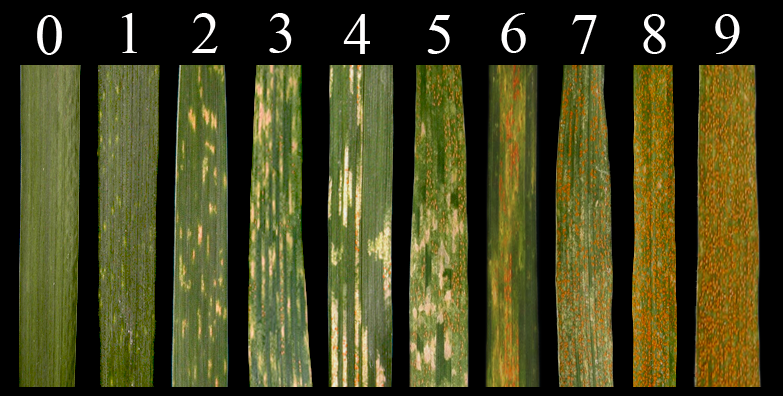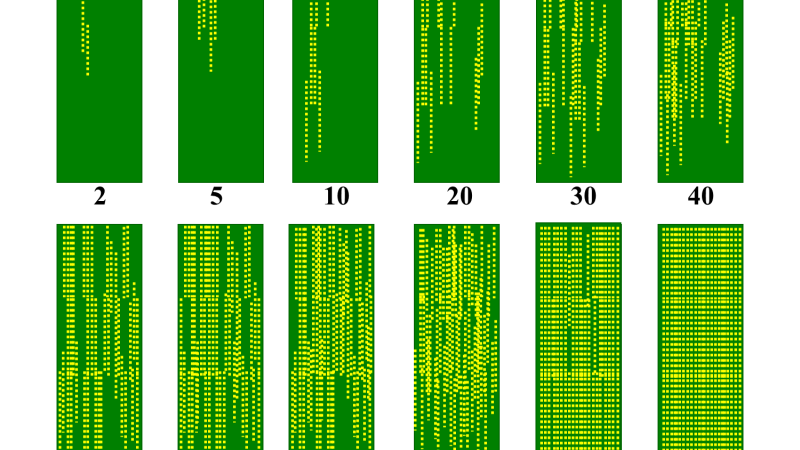Resistance
Stripe rust can be best controlled by growing resistant varieties, which does not add additional cost and does not adversely affect the environment. There are different types of genetic resistance, mostly all-stage resistance and high-temperature adult-plant (HTAP) resistance.
All-stage resistance
All-stage resistance (also known as seedling resistance) is expressed in every stage of plant growth. This type of resistance usually provides complete protection when it is effective. All-stage resistance is generally controlled by a single race-specific gene. When the resistance gene is overcome by a virulent race of the pathogen it will be no longer effective and the variety will become highly susceptible. All-stage resistance conferred by several pyramided effective all-stage resistance genes will last longer than single-gene-controlled all-stage resistance. Multi-line varieties and variety mixtures with different effective genes can provide long lasting all-stage resistance.
HTAP resistance
HTAP resistance is expressed when the weather becomes warmer and the plants grow older. Varieties with only HTAP resistance are susceptible in the seedling stage, but become resistant generally after stem elongation in the late growing season. HTAP resistance is durable but may not provide complete protection. This type of resistance is controlled by one or more quantitative trait loci (QTL). Pyramiding different QTL can increase the level of HTAP resistance. HTAP resistance is generally non-race specific, though some adult-plant resistance can be race-specific.
Combining effective all-stage resistance with HTAP resistance is the best approach to develop varieties that provide both durable and complete protection from stripe rust.

For selecting stripe rust resistant varieties to grow, please refer to the current “Seed Buyer’s Guide” and the most recent stripe rust data for your region. For U.S. Pacific Northwest growers please go to the Cultivar Resistance & Yield Loss Data and Nursery Data pages.
References
- Chen, X. M. 2005. Epidemiology and control of stripe rust [Puccinia striiformis f. sp. tritici] on wheat. Canadian Journal of Plant Pathology 27:314-337.
Cultural Practices
Stripe rust development is affected by cultural practices. Appropriate cultural practices can reduce stripe rust damage:
- Plant resistant varieties and withdraw susceptible varieties from production. For selecting stripe rust resistant varieties for growing in the U.S. Pacific Northwest, please refer to Seed Buyer’s Guide and Cultivar Resistance & Yield Loss Data.
- Avoid early planting of winter wheat. The earlier the winter wheat is planted in the fall, the more likely the plants are to get infected by stripe rust. Relatively late planting can reduce stripe rust infection. However, to choose planting dates, growers should also consider other factors, such as soil moisture, for the best crop.
- Reduce volunteer plants and grasses. Volunteer plants of susceptible wheat cultivars and some grasses can serve as hosts to carry stripe rust from season to season. Reducing volunteer plants and grasses can reduce rust inoculum.
- Avoid excessive irrigation. The stripe rust fungus likes high moisture for infecting crops. Reducing moisture can reduce rust development.
- Avoid excessive fertilization. Excessive fertilization can cause overcrowded crops which makes stripe rust develop faster.
For stripe rust management, crop rotation generally does not have any effect as rust spores are airborne, not soilborne.
Fungicide
Appropriate use of fungicides can provide effective control when stripe rust has potential to cause significant yield loss. The factors related to fungicide application include: susceptibility of varieties, timing of application, individual fungicides, disease pressure, weather conditions, yield potential, and grain price.
To determine whether fungicides should be used or not, growers should consider the susceptibility (or the level of resistance) of varieties, disease pressure, yield potential, grain price, and fungicide and application cost. Many of these factors can vary from year to year. For varieties with a high level of resistance, fungicide application is not needed. For highly susceptible varieties, fungicide application is needed almost every year. For moderately susceptible and moderately resistant varieties, fungicide application may be needed depending upon the level of resistance, disease pressure, and weather conditions.
To know the level of resistance of a particular variety, please refer to the current “Seed Buyer’s Guide” and the most recent stripe rust data for your region. For U.S. Pacific Northwest growers, please refer to Seed Buyer’s Guide and Cultivar Resistance & Yield Loss Data. Please keep in mind that resistance will likely degrade over time, especially for varieties with a high level of all-stage resistance, which is influenced by different races of the pathogen. Also, varieties with adequate resistance in the past may not have adequate protection in the future, especially for varieties with high-temperate adult-plant (HTAP) resistance, which is influenced by disease pressure, and weather conditions. A high level of resistance in a variety with a combination of all-stage resistance and HTAP resistance can be reduced to a low level by changes in pathogen races and frequencies.
The best practice for determining whether or not fungicide should be used is to check fields early on in the stripe rust development season. If stripe rust reaches to an incidence (number of plants with rust) or severity (percentage of leaf areas with rust) of 1-5% (see Figure 1), fungicide application should be done immediately, unless a field is grown with a single variety of plants, a multi-line variety composed of different lines, and a mixture of two or more varieties with different reactions to stripe rust.

One of the important time points to consider whether fungicide should be used or not is the time when herbicide application is needed. Because fungicide can be mixed with herbicide, use of fungicide together with herbicide can save application cost. Occasionally, fungicide application is needed before the time of herbicide application if stripe rust infection is heavy and widespread before winter, the winter is mild which allows the stripe rust pathogen to survive the winter, or the pathogen develops very early in the spring. Often, stripe rust starts developing after herbicide application. If rust is going to appear within 3 weeks after herbicide application, which can be determined by rust situations in surrounding areas, fungicide mixed with herbicide is useful for delaying stripe rust in the field depending upon susceptibility of the variety. Figure 2 shows the general scheme of stripe rust management related to crop growth stages.
Two or more applications may be needed during a single growing season if stripe rust develops very early and weather conditions (low temperature and high moisture) continue to be favorable for stripe rust. The currently registered fungicides can protect the crop for 20-40 days (see Table 1 below). The next application should be done 7 days before the limit of the protection period. If only one fungicide application is profitable, the application should be done between the heading and flowering stages for maximum protection of the grain filling stage.